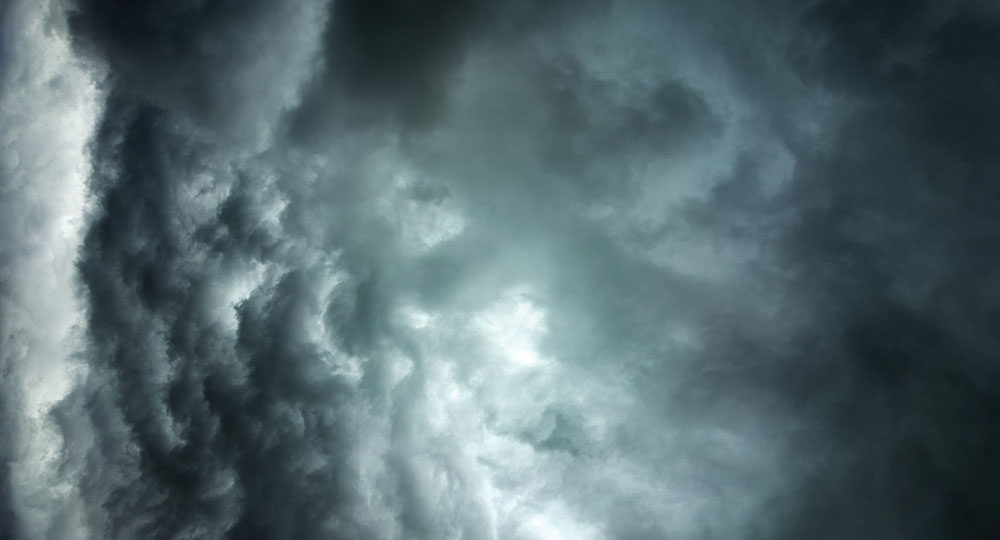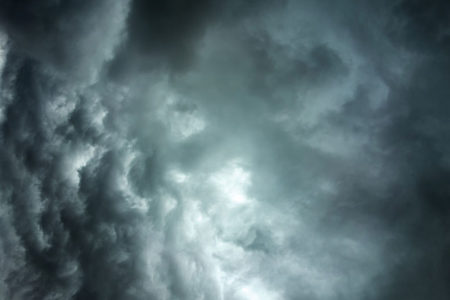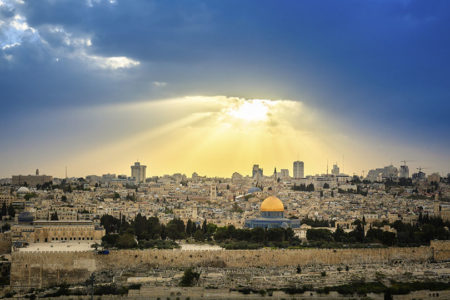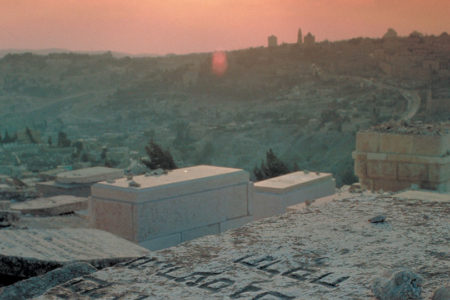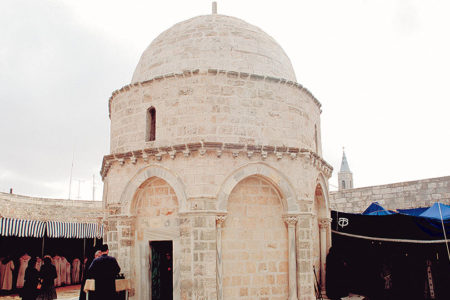Jerusalem: In the Eye of the Storm Zechariah 12
A story is told of the prime minister of Israel exchanging visits with the president of the United States. On the president’s desk were three telephones-one red, one white, and one blue. When the prime minister inquired about them, the president replied that the red one was a direct line to Moscow; the blue one, a direct line to London; and the white one, a direct line to God. Asked if he used the white one often, the president replied that he used it rarely since calls to God were long-distance and therefore expensive.
The Israeli prime minister remarked that he also had three such telephones. The red one was to Paris; the blue one, to London; and the white one went directly to God. The president asked him if he used the white one often.
“Sometimes a number of times each day,” the prime minister replied. Surprised, the president asked how the Israeli government could handle such a large telephone bill.
“It really is not that expensive to call God,” the prime minister said. “In Jerusalem, it’s a local call.”
Although being in Jerusalem will not automatically make you closer to God, the city certainly occupies a central place in the divine purpose. It is a city with an amazing past, an exciting present, and a remarkable future. Although Jerusalem has been shifted at times off the center stage of history, it always seems to return there as the central concern of the nations—and we seem to be in one of those periods today.
Prophetically, the Scriptures foretell that Jerusalem will again be at the center of the eschatological scene. Zechariah chapters 12 and 14 mention Jerusalem twenty-one times in thirty-five verses. In Zechariah 12 we read about a siege of Jerusalem that will recur, a Savior of Jerusalem who will return, and a salvation of Jerusalem that will result.
The Siege of Jerusalem
Zechariah 12:1-6 describes a scene of pain and destruction that will occur toward the end of the Tribulation, right before the Lord returns in glory. Although the text graphically describes the horrors of a military siege by the world’s armies, it also shows clearly that the sovereign Lord is still in control and orchestrates even the wrath of man to accomplish His purposes.
Two vivid metaphors describe Jerusalem’s plight: a cup and a stone.
Behold, I will make Jerusalem a cup of trembling unto all the peoples round about, when they shall be in the siege both against Judah and against Jerusalem. And in that day will I make Jerusalem a burdensome stone for all peoples; all that burden themselves with it shall be cut in pieces, though all the nations of the earth be gathered together against it (12:2–3).
Jerusalem is compared to a large cup or bowl that will be filled with wine the nations seek to drink dry. In other words, the nations want to “drain” Jerusalem, removing it forever. However, their plan will backfire. When they remove the “liquid” from the “cup,” it will make them drunk; and they will tremble, stagger, and fall. It is not the cup that will be destroyed; it is the nations.
A similar event will occur when the nations seek to remove the “stone” impeding their plans. The stone will roll backward on them and destroy them. They will be “cut in pieces” by it.
With these graphic word pictures, the Lord describes the harsh fulfillment in the end-times of the Abrahamic Covenant principle first enunciated in Genesis 12:3: “And I will bless them that bless thee, and curse him that curseth thee.” Although the Gentile nations have oppressed and even tried to destroy little Israel throughout her long history, they will be punished in the end for daring to touch the “apple of his eye” (Zech. 2:8).
Their punishment will consist of “madness” and “fire” brought on those who will dare lay siege to the Holy City.
The Savior of Jerusalem
Zechariah 12:7–10 describes how the Lord will deliver suffering Israel at the height of the siege. Physical salvation will be followed by spiritual salvation. Most important is that the Lord (Hebrew, Yahweh) will be the Savior.
First, the Lord “shall save the tents of Judah” (v. 7). The word tents may be a figure for Jewish people who live outside Jerusalem, perhaps even those who live outside the land of Israel in their temporary dwellings (“tents”) in the Diaspora. Second, the Lord will defend the inhabitants of Jerusalem (v. 9). These are the Jewish people who will be holed up in their Holy City as a last stand during the Armageddon campaign described in Joel 3:9–17; Isaiah 63:1–6; and Revelation 16:12–16. Zechariah’s parallel, chapter 14, describes this group as a small remnant that has survived this final stage of the “day of the LORD” (14:1). The prophet Jeremiah called this awful period “the time of Jacob’s trouble, but he shall be saved out of it” (Jer. 30:7).
Third, the Savior of Jerusalem will follow His physical salvation of the Jerusalem remnant with an effusion of His Spirit, causing individual, spiritual salvation:
And I will pour upon the house of David, and upon the inhabitants of Jerusalem, the Spirit of grace and of supplications; and they shall look upon me whom they have pierced (12:10).
Here is one of the most remarkable verses in God’s Word. Throughout this passage, the “I” has been the Lord (12:2–4, 6, 9).
That same Lord, the Creator of the heavens and the earth (v. 1), will not only pour out His Spirit on Jerusalem’s inhabitants but also will be looked to as one whom they earlier had pierced.
The language is clear and exactly translates the original Hebrew: “They shall look upon me whom they have pierced.” The word pierced translates a Hebrew word used elsewhere in the Old Testament for an act that inflicts a violent death. (See Numbers 25:8; Judges 9:54; and 1 Samuel 31:4.) It is clear that the one who will receive the gaze of faith is one who has been pierced and killed. And the one who was pierced is none other than the Lord Himself. No amount of explaining away the text can avoid these conclusions, which are clearly conveyed in the original language. Modern language translations, such as the New International Version, New American Standard Bible, and English Standard Version, all take the words as applying to the Lord, whom the men of old had pierced.
How could the Lord have been pierced? And how can a Jewish remnant look for deliverance to one who has been killed?
There is only one answer to these questions. The only way Zechariah 12:10 makes sense is if the Lord in some way allowed Himself to be pierced and killed. But how could the infinite Lord suffer piercing? The answer can only be that He assumed a body of flesh that could receive a death thrust. John’s account of Jesus’ crucifixion confirms this fact:
For these things were done [His piercing with nails and spear, Jn. 19:18, 34], that the scripture should be fulfilled, A bone of him shall not be broken. And, again, another scripture saith, They shall look on him whom they pierced (Jn. 19:36-37).
The crucifixion piercing of Jesus was the piercing of God Himself referred to in Zechariah 12:10. And it could only have been possible if God, who is pure spirit, took on Himself the flesh of humanity. This amazing act is exactly what the New Testament describes as the wonder of the incarnation: “And the Word was made flesh, and dwelt among us” (Jn. 1:14).
Furthermore, the only way a future Jewish remnant will be able to look in faith to one who died is if the Lord has returned from that death experience. The fact of His piercing will leap to the minds of those who will recognize Him as their Messiah. They will see Him not simply as crucified but as alive, not dead. Thus Zechariah 12:10 also implies a resurrection from death-an event that John also carefully recorded in his Gospel (Jn. 19:38-20:20).
Zechariah 12: 10 is one of the most important of the Messianic prophecies. Its relevance to Jesus is further confirmed by its application to Him in Revelation 1 :7: “Behold, he cometh with clouds, and every eye shall see him, and they also who pierced him; and all kindreds of the earth shall wail because of him.”
The Salvation of Jerusalem
The “wailing” of Revelation 1:7 echoes the context of the “piercing” prophecy in Zechariah 12:10. The immediate result of Israel’s looking to Jesus as He returns to deliver them is that the Jewish people will mourn and wail throughout their society. The verse concludes, “and they shall mourn for him, as one mourneth for his only son, and shall be in bitterness for him, as one that is in bitterness for his firstborn” (12:10).
This deep and thorough mourning in repentance will extend to all levels of Jewish society. (See verses 11-14.) Zechariah 13:1 clearly shows that the mourning will lead to a cleansing from sin: “In that day there shall be a fountain opened to the house of David and to the inhabitants of Jerusalem for sin and for uncleanness.”
This repentance and cleansing describe what other passages also affirm, namely, Israel will undergo a national cleansing. This salvation is mentioned not only by the Hebrew prophets but also by the apostle Paul in Romans 11:26-27:
“And so all Israel shall be saved; as it is written, There shall come out of Zion the Deliverer, and shall turn away ungodliness from Jacob; Fo this is my covenant unto them, when I shall take away their sins.”
Zechariah 12:10-14 describes Israel’s repentance in terms of sorrow and mourning. The language recalls another amazing Messianic prophecy-that of Isaiah’s Suffering Servant in Isaiah 52:13-53:12. This “penitential dirge” may perhaps become the words repentant Israel will say as it mourns in sorrow over its rejected and crucified Messiah. On that day, Zechariah 12:10-14 will find its fulfillment:
He is despised and rejected of men, a man of sorrows, and acquainted with grief, and we hid as it were our faces from him; he was despised, and we esteemed him not.
Surely he hath borne our griefs, and carried our sorrows; yet we did esteem him stricken, smitten of God, and afflicted. But he was wounded for our transgressions, he was bruised for our iniquities; the chastisement for our peace was upon him, and with his stripes we are healed. All we like sheep have gone astray; we have turned every one to his own way, and the LORD hath laid on him the iniquity of us all (Isa. 53:3-6).
The book of Zechariah teaches that the Jewish people must go through a dark period before the light breaks forth and all Israel will be saved. Israel’s long night of exile from her land and also from her Lord will end someday. O Lord, hasten that day!
